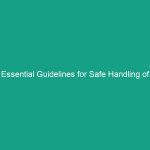Essential Guidelines to Combat Workplace Complacency and Boost Safety
Introduction
Good morning, team! Today, we’re here to discuss a crucial topic that affects all of us: workplace complacency and its impact on our Safety. This Toolbox Talk is designed to help you recognize the signs of complacency, understand its risks, and implement actionable strategies to foster a culture of safety in our work Environment. It’s important because complacency can lead to accidents, injuries, and even fatalities. Let’s dive into why this topic matters and how we can collectively boost our safety practices.
Understanding Workplace Complacency
Workplace complacency refers to a state where employees become overly comfortable or indifferent towards their safety responsibilities. This often occurs when individuals perform their tasks repeatedly without incident, leading to a false sense of security. The risks associated with complacency can be significant—ignoring safety protocols can result in accidents, injuries, or damage to equipment.
One common misconception is that safety issues only arise from new tasks or unfamiliar environments. In reality, complacency can emerge even in routine tasks. It’s crucial to remain vigilant and aware of the potential Hazards we face daily.
Key Hazards, Risks, and Safety Considerations
Complacency in the workplace can lead to various hazards, including:
- Inattentiveness: Overlooking critical safety checks or ignoring warning signs.
- Disregarding Personal Protective Equipment (PPE): Failing to wear or properly use PPE because it feels unnecessary in familiar tasks.
- Neglecting Procedures: Skipping established safety protocols in favor of getting the job done quickly.
The real-world consequences of complacency can be severe. For instance, studies show that a significant percentage of workplace accidents occur during routine tasks when employees let their guard down. Recognizing and addressing these risks is essential to maintaining a safe work environment.
Best Practices, Procedures, & Actionable Advice
To combat workplace complacency, consider implementing the following Best Practices:
- Regular Training: Conduct safety training sessions regularly to refresh employees’ knowledge and awareness of safety practices.
- Safety Audits: Perform routine safety audits to identify potential hazards and ensure compliance with safety protocols. Engage employees in this process to foster a sense of ownership.
- Encourage Communication: Foster an open environment where employees feel comfortable discussing safety concerns or suggesting improvements.
- Establish Safety Champions: Appoint safety champions on each team to promote safety discussions and practices actively.
- Reward Safe Behavior: Recognize and reward employees for practicing safety and reporting hazards, reinforcing positive behavior.
For example, consider a case where a construction team regularly performed the same task without incident. One day, a worker skipped a safety check, leading to a preventable accident. This incident highlights the importance of adhering to safety protocols, regardless of familiarity with the task.
Regulations, Standards, and Compliance
Compliance with safety Regulations is critical to ensuring a safe workplace. Relevant Standards may include OSHA regulations, ISO certifications, or specific company Safety Guidelines. Understanding these regulations not only protects employees but also enhances the overall safety culture of the organization.
Failure to comply with safety regulations can result in fines, legal issues, and, most importantly, injuries. It’s essential for everyone to be aware of the standards applicable to their roles and actively participate in maintaining compliance.
Employee Engagement & Discussion
Now, let’s open the floor for discussion. Consider these questions:
- What safety challenges have you encountered related to complacency?
- Can you share a time when staying vigilant helped you avoid an accident?
- What suggestions do you have for enhancing our safety practices?
Your insights are invaluable; sharing experiences can help us all learn and improve our safety culture.
Conclusion & Key Takeaways
To wrap up, combating workplace complacency is essential for maintaining a safe and productive work environment. Remember these key points:
- Stay vigilant and prioritize safety, even in routine tasks.
- Engage in regular training and safety audits to reinforce safety practices.
- Communicate openly about safety concerns and suggestions.
- Understand and comply with relevant safety regulations.
- Recognize safe behavior and encourage a culture of safety.
Thank you for your attention and commitment to safety. Let’s work together to foster a culture that prioritizes safety, ensuring that we all return home safe and sound at the end of the day.


